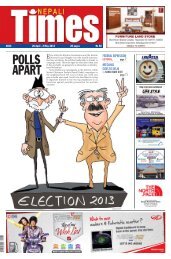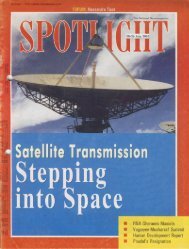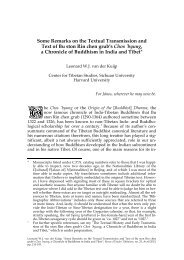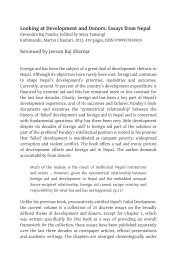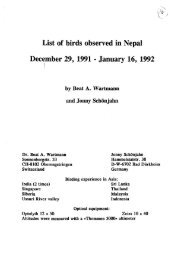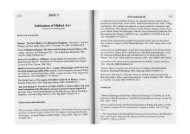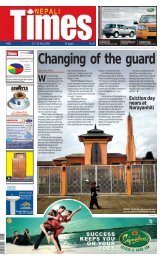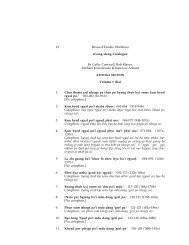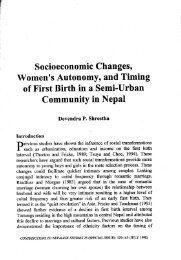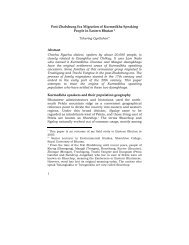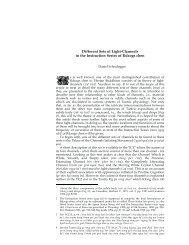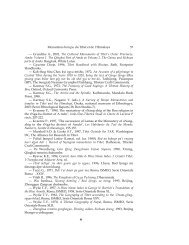You also want an ePaper? Increase the reach of your titles
YUMPU automatically turns print PDFs into web optimized ePapers that Google loves.
Khula Manch<br />
40<br />
Ferryman, Get Me<br />
Across The Seas<br />
The frequency of bandas has disrupted academic<br />
life, forcing increasing numbers of students to<br />
seek educational opportunities abroad. The<br />
United States remains one of the most sought-after<br />
destinations—the growth rates of Nepali student<br />
applicants for the United States is among<br />
the highest in the world. Michael Gill,<br />
the executive director of the Fulbright<br />
Commission for Educational Exchange<br />
between the United States and Nepal,<br />
talked with Sushma Joshi of <strong>Nation</strong><br />
<strong>Weekly</strong> about this outward move. Gill’s<br />
association with Nepal goes back to the<br />
mid 1960s, when he was a Peace Corps<br />
Volunteer.<br />
Is Nepal among the countries with the<br />
highest numbers of students applying<br />
for visas to study in the United States?<br />
Not in terms of absolute numbers, but<br />
the rate of growth of student applicants<br />
is amongst the highest in the world. The<br />
growth rates of other countries that have<br />
traditionally sent high numbers have leveled<br />
off.<br />
Do you see any patterns in the Nepali<br />
educational system?<br />
Most Nepali students are pushed into<br />
the sciences by employment options,<br />
and through family pressure. We get<br />
many applicants for the Fulbright who<br />
have done many years in science. We have<br />
a student trained as an engineer who<br />
worked for many years for an NGO<br />
building water systems. The system kept<br />
on failing, and not because of technical<br />
reasons. So finally, he started to study<br />
rural sociology in order to understand<br />
what’s going on at a social level. That’s a<br />
fairly typical pattern—coming out of the<br />
sciences and going into other fields of<br />
study.<br />
What’s missing here that students can<br />
get in the United States?<br />
The lamentable thing about the Nepali<br />
educational system is its devaluation of<br />
the humanities and social sciences, not<br />
just at the undergraduate level, but even<br />
at high school and primary school levels.<br />
I happen to believe that a liberal education<br />
such as the ones colleges in the<br />
United States provide is a real development.<br />
Do you see any moves towards developing<br />
this system of liberal education<br />
in Nepal?<br />
A number of people have been pushing<br />
this idea in Nepal. The proliferation of<br />
MBA programs is also a start, although<br />
it starts at the top, instead of at the bottom—the<br />
critical thinking and individual<br />
research skills of a liberal education<br />
need to be introduced in college,<br />
The lamentable<br />
thing about the<br />
Nepali educational<br />
system is its<br />
devaluation of the<br />
humanities and<br />
social sciences.<br />
and if possible, even further back in primary<br />
school. Knowledge is not something<br />
that can be created like a mother<br />
bird vomiting regurgitated food into the<br />
baby’s mouth. It can’t be learnt through<br />
rote.<br />
Individual efforts and the contribution<br />
of private institutions are of course important,<br />
since they are the seed of<br />
larger developments. But has anything<br />
been done at a national level to implement<br />
these ideas?<br />
I am not involved in, or privy to, or updated<br />
on government thinking on this<br />
area. My job is to provide information<br />
to students who seek to get an education<br />
in the United States.<br />
What does your work entail?<br />
Part of our job is to figure out if study in<br />
the United States is appropriate for a student<br />
or not. Many times, it’s not. Education<br />
in the United States is very expensive—an<br />
average of $20,000 a year. Seventy<br />
percent of our students who go are<br />
self-funded. Of the other 30 percent, only<br />
a small fraction get total financial aid.<br />
You administer the Fulbright program,<br />
one of the most sought-after fellowships<br />
to the United States. Do you find that<br />
people use it as an entryway to migrate<br />
to the United States?<br />
We have a 100 percent rate of return of<br />
our fellows. Our job is not to fund foreign<br />
students to find employment in the<br />
United States. Most of the students we<br />
select go in areas for which there is not a<br />
big employment market in the United<br />
States, everything from art to creative<br />
writing. We do not fund medicine, engineering<br />
and IT students.<br />
Will institutions in Nepal increasingly<br />
offering more liberal arts-oriented academics<br />
discourage the trend to study<br />
aboard?<br />
Private education will continue to grow<br />
in Nepal—I don’t see anything wrong<br />
with private education per se. But if Nepal<br />
is serious about universal education, they<br />
have to strengthen the state of education<br />
in Nepal at the public level.<br />
MAY 30, 2004 | nation weekly<br />
nw/SS




